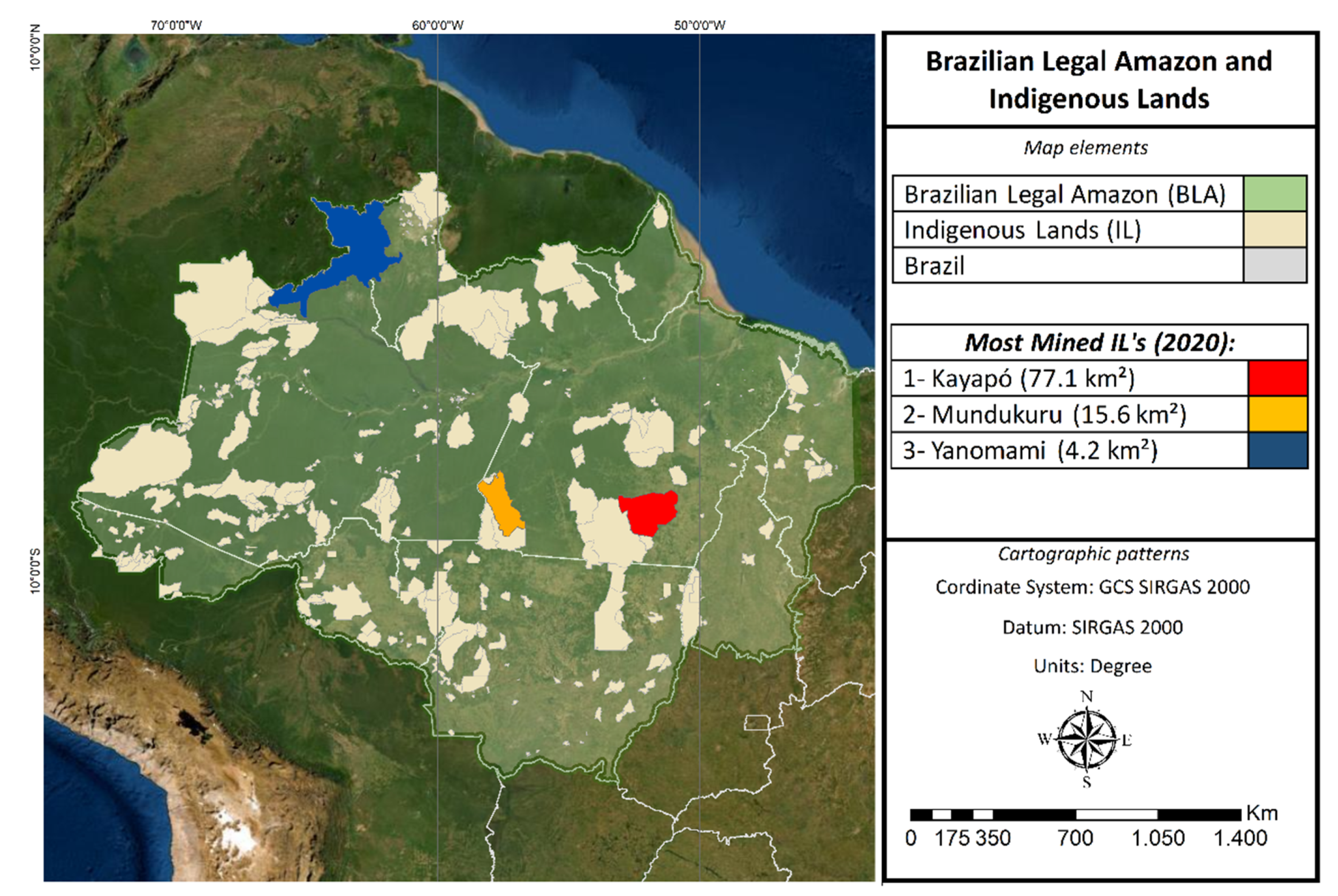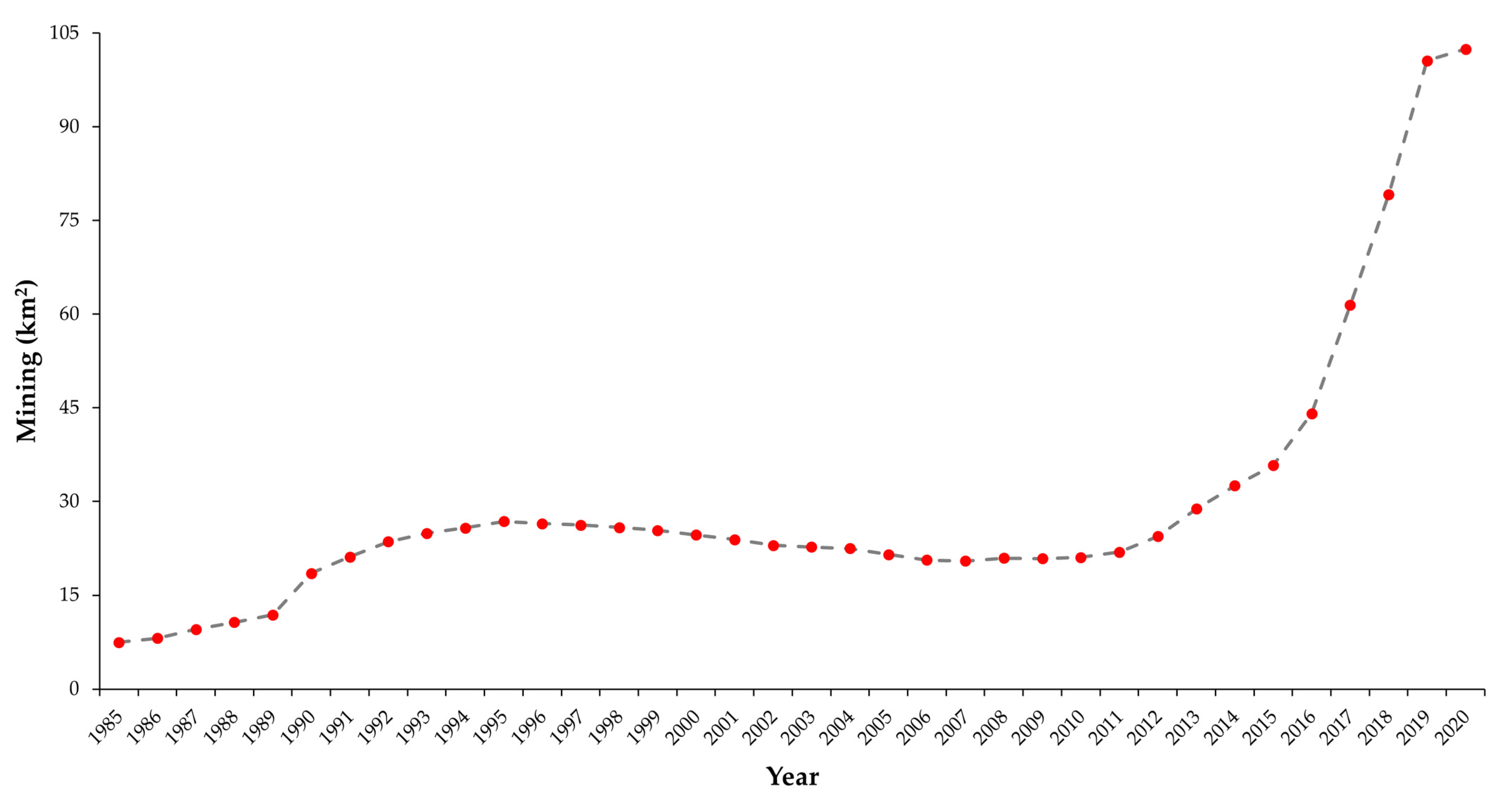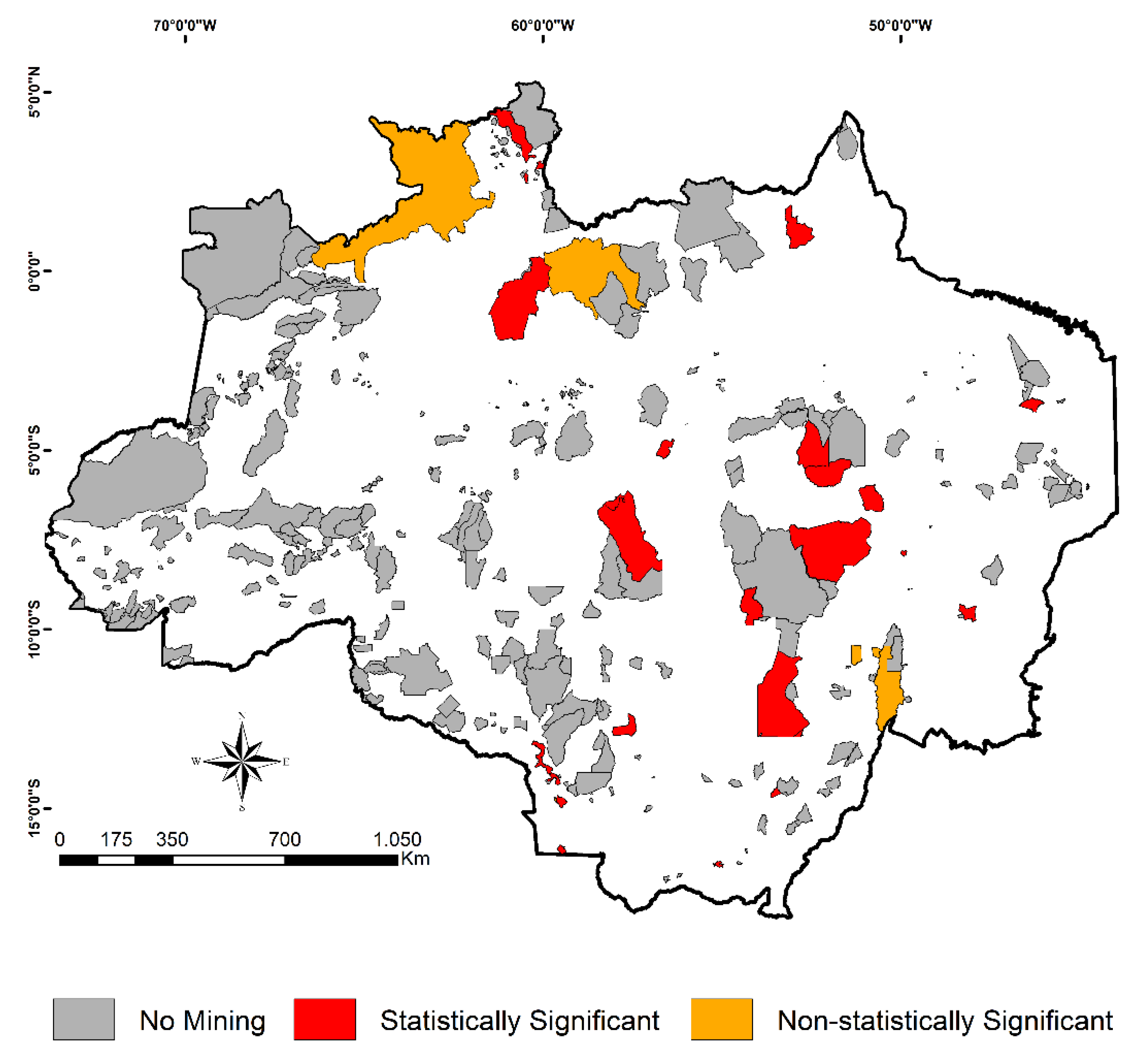Mining Is a Growing Threat within Indigenous Lands of the Brazilian Amazon
Abstract
:1. Introduction
2. Materials and Methods
2.1. Indigenous Lands within the Brazilian Legal Amazon
2.2. Identifying Mining Areas within Indigenous Lands
2.3. Detecting Trends in the Mining Activity within Indigenous Lands
3. Results
4. Discussion
5. Conclusions
Author Contributions
Funding
Data Availability Statement
Conflicts of Interest
References
- Malhi, Y.; Gardner, T.A.; Goldsmith, G.R.; Silman, M.R.; Zelazowski, P. Tropical Forests in the Anthropocene. Annu. Rev. Environ. Resour. 2014, 39, 125–159. [Google Scholar] [CrossRef]
- Watson, J.E.M.; Evans, T.; Venter, O.; Williams, B.; Tulloch, A.; Stewart, C.; Thompson, I.; Ray, J.C.; Murray, K.; Salazar, A.; et al. The exceptional value of intact forest ecosystems. Nat. Ecol. Evol. 2018, 2, 599–610. [Google Scholar] [CrossRef] [PubMed]
- Brandon, K. Ecosystem Services from Tropical Forests: Review of Current Science. SSRN Electron. J. 2014, 380. [Google Scholar] [CrossRef]
- Gatti, L.V.; Basso, L.S.; Miller, J.B.; Gloor, M.; Gatti Domingues, L.; Cassol, H.L.G.; Tejada, G.; Aragao, L.; Nobre, C.; Peters, W.; et al. Amazonia as a carbon source linked to deforestation and climate change. Nature 2021, 595, 388–393. [Google Scholar] [CrossRef] [PubMed]
- Barlow, J.; Berenguer, E.; Carmenta, R.; Franca, F. Clarifying Amazonia’s burning crisis. Glob. Chang. Biol. 2020, 26, 319–321. [Google Scholar] [CrossRef]
- Bullock, E.L.; Woodcock, C.E.; Souza, C., Jr.; Olofsson, P. Satellite-based estimates reveal widespread forest degradation in the Amazon. Glob. Chang. Biol. 2020, 26, 2956–2969. [Google Scholar] [CrossRef]
- de Oliveira, G.; Brunsell, N.A.; Chen, J.M.; Shimabukuro, Y.E.; Mataveli, G.A.V.; dos Santos, C.A.C.; Stark, S.C.; de Lima, A.; Aragao, L.E.O.C. Legacy Effects Following Fire on Surface Energy, Water and Carbon Fluxes in Mature Amazonian Forests. J. Geophys. Res. Biogeosci. 2021, 126, e2020JG005833. [Google Scholar] [CrossRef]
- van der Werf, G.R.; Randerson, J.T.; Giglio, L.; van Leeuwen, T.T.; Chen, Y.; Rogers, B.M.; Mu, M.; van Marle, M.J.E.; Morton, D.C.; Collatz, G.J.; et al. Global fire emissions estimates during 1997–2016. Earth Syst. Sci. Data 2017, 9, 697–720. [Google Scholar] [CrossRef]
- Amaral, S.S.; Costa, M.A.M.; Soares Neto, T.G.; Costa, M.P.; Dias, F.F.; Anselmo, E.; Santos, J.C.D.; Carvalho, J.A., Jr. CO2, CO, hydrocarbon gases and PM2.5 emissions on dry season by deforestation fires in the Brazilian Amazonia. Environ. Pollut. 2019, 249, 311–320. [Google Scholar] [CrossRef]
- Federative Republic of Brazil. Constitution of the Federative Republic of Brazil. Available online: http://www2.senado.leg.br/bdsf/bitstream/handle/id/518231/CF88_Livro_EC91_2016.pdf (accessed on 2 June 2022).
- Escobar, H. Brazil’s deforestation is exploding—And 2020 will be worse. Science 2019, 22. [Google Scholar] [CrossRef]
- Vale, M.M.; Berenguer, E.; Argollo de Menezes, M.; Viveiros de Castro, E.B.; Pugliese de Siqueira, L.; Portela, R.C.Q. The COVID-19 pandemic as an opportunity to weaken environmental protection in Brazil. Biol. Conserv. 2021, 255, 108994. [Google Scholar] [CrossRef]
- National Institute for Space Research (INPE). Monitoring of the Brazilian Amazon Deforestation by Satellite. Available online: http://terrabrasilis.dpi.inpe.br/app/dashboard/deforestation/biomes/legal_amazon/rates (accessed on 31 May 2022).
- Amigo, I. Indigenous communities in Brazil fear pandemic’s impact. Science 2020, 368, 352. [Google Scholar] [CrossRef] [PubMed]
- Conceição, K.V.; Chaves, M.E.D.; Picoli, M.C.A.; Sánchez, A.H.; Soares, A.R.; Mataveli, G.A.V.; Silva, D.E.; Costa, J.S.; Camara, G. Government policies endanger the indigenous peoples of the Brazilian Amazon. Land Use Policy 2021, 108, 105663. [Google Scholar] [CrossRef]
- Rorato, A.C.; Picoli, M.C.A.; Verstegen, J.A.; Camara, G.; Silva Bezerra, F.G.; Escada, M.I.S. Environmental Threats over Amazonian Indigenous Lands. Land 2021, 10, 267. [Google Scholar] [CrossRef]
- Mataveli, G.; de Oliveira, G. Protect the Amazon’s Indigenous lands. Science 2022, 375, 275–276. [Google Scholar] [CrossRef]
- Ferrante, L.; Fearnside, P.M. Brazilian government violates Indigenous rights: What could induce a change? J. Geogr. Soc. Berl. 2021, 152, 200–211. [Google Scholar] [CrossRef]
- Villén-Pérez, S.; Anaya-Valenzuela, L.; Conrado da Cruz, D.; Fearnside, P.M. Mining threatens isolated indigenous peoples in the Brazilian Amazon. Glob. Environ. Change 2022, 72, 102398. [Google Scholar] [CrossRef]
- Neves, R. Pedidos de mineração Atingem Mais de 200 Terras Indígenas na Amazônia. Available online: http://noticias.uol.com.br/meio-ambiente/ultimas-noticias/redacao/2022/03/13/pedidos-de-mineracao-atingem-4-em-cada-10-terras-indigenas-no-brasil.htm (accessed on 7 June 2022).
- Siqueira-Gay, J.; Sánchez, L.E. The outbreak of illegal gold mining in the Brazilian Amazon boosts deforestation. Reg. Environ. Change 2021, 21, 28. [Google Scholar] [CrossRef]
- Begotti, R.A.; Peres, C.A. Rapidly escalating threats to the biodiversity and ethnocultural capital of Brazilian Indigenous Lands. Land Use Policy 2020, 96, 104694. [Google Scholar] [CrossRef]
- Bratman, E.; Dias, C.B. Development blind spots and environmental impact assessment: Tensions between policy, law and practice in Brazil’s Xingu river basin. Environ. Impact Assess. Rev. 2018, 70, 1–10. [Google Scholar] [CrossRef]
- Siqueira-Gay, J.; Soares-Filho, B.; Sanchez, L.E.; Oviedo, A.; Sonter, L.J. Proposed Legislation to Mine Brazil’s Indigenous Lands Will Threaten Amazon Forests and Their Valuable Ecosystem Services. One Earth 2020, 3, 356–362. [Google Scholar] [CrossRef] [PubMed]
- Federative Republic of Brazil. Confira a Íntegra do Discurso do Ministro Joaquim Leite na Plenária da Cúpula do Clima. Available online: http://www.gov.br/mma/pt-br/noticias/confira-a-integra-do-discurso-do-ministro-joaquim-leite-na-plenaria-da-cupula-do-clima (accessed on 2 June 2022).
- International Labour Organization (ILO). ILO Indigenous and Tribal Peoples Convention (No. 169). Available online: http://www.ilo.org/dyn/normlex/en/f?p=NORMLEXPUB:12100:0::NO:12100:P12100_INSTRUMENT_ID:312314:NO (accessed on 4 June 2022).
- MapBiomas. Project MapBiomas—Collection 6.0 of Brazilian Land Cover & Use Map Series. Available online: http://mapbiomas.org/en (accessed on 1 June 2022).
- Diniz, C.G.; Souza, A.A.d.A.; Santos, D.C.; Dias, M.C.; Luz, N.C.d.; Moraes, D.R.V.d.; Maia, J.S.A.; Gomes, A.R.; Narvaes, I.d.S.; Valeriano, D.M.; et al. DETER-B: The New Amazon Near Real-Time Deforestation Detection System. IEEE J. Sel. Top. Appl. Earth Obs. Remote Sens. 2015, 8, 3619–3628. [Google Scholar] [CrossRef]
- Paiva, P.F.P.R.; de Lourdes Pinheiro Ruivo, M.; da Silva Júnior, O.M.; de Nazaré Martins Maciel, M.; Braga, T.G.M.; de Andrade, M.M.N.; dos Santos Junior, P.C.; da Rocha, E.S.; de Freitas, T.P.M.; da Silva Leite, T.V.; et al. Deforestation in protect areas in the Amazon: A threat to biodiversity. Biodivers. Conserv. 2019, 29, 19–38. [Google Scholar] [CrossRef]
- Fuller, C.; Ondei, S.; Brook, B.W.; Buettel, J.C. Protected-area planning in the Brazilian Amazon should prioritize additionality and permanence, not leakage mitigation. Biol. Conserv. 2020, 248, 108673. [Google Scholar] [CrossRef]
- Rorato, A.C.; Camara, G.; Escada, M.I.S.; Picoli, M.C.A.; Moreira, T.; Verstegen, J.A. Brazilian amazon indigenous peoples threatened by mining bill. Environ. Res. Lett. 2020, 15, 1040a3. [Google Scholar] [CrossRef]
- Indigenous Lands of Brazil. Yanomami Indigenous Land. Available online: http://terrasindigenas.org.br/en/terras-indigenas/4016 (accessed on 1 June 2022).
- Indigenous Lands of Brazil. Mundurukú Indigenous Land. Available online: http://terrasindigenas.org.br/en/terras-indigenas/3770 (accessed on 1 June 2022).
- Indigenous Lands of Brazil. Kayapó Indigenous Land. Available online: http://terrasindigenas.org.br/en/terras-indigenas/3731 (accessed on 1 June 2022).
- Nunes, S.; Oliveira, L.; Siqueira, J.; Morton, D.C.; Souza, C.M. Unmasking secondary vegetation dynamics in the Brazilian Amazon. Environ. Res. Lett. 2020, 15, 034057. [Google Scholar] [CrossRef]
- Silva Junior, C.H.L.; Heinrich, V.H.A.; Freire, A.T.G.; Broggio, I.S.; Rosan, T.M.; Doblas, J.; Anderson, L.O.; Rousseau, G.X.; Shimabukuro, Y.E.; Silva, C.A.; et al. Benchmark maps of 33 years of secondary forest age for Brazil. Sci. Data 2020, 7, 269. [Google Scholar] [CrossRef]
- Silva Junior, C.H.L.; Celentano, D.; Rousseau, G.X.; de Moura, E.G.; Varga, I.v.D.; Martinez, C.; Martins, M.B. Amazon forest on the edge of collapse in the Maranhão State, Brazil. Land Use Policy 2020, 97, 104806. [Google Scholar] [CrossRef]
- Guerrero, J.V.R.; Escobar-Silva, E.V.; Chaves, M.E.D.; Mataveli, G.A.V.; Bourscheidt, V.; de Oliveira, G.; Picoli, M.C.A.; Shimabukuro, Y.E.; Moschini, L.E. Assessing Land Use and Land Cover Changes in the Direct Influence Zone of the Braço Norte Hydropower Complex, Brazilian Amazonia. Forests 2020, 11, 988. [Google Scholar] [CrossRef]
- Mataveli, G.A.V.; de Oliveira, G.; Seixas, H.T.; Pereira, G.; Stark, S.C.; Gatti, L.V.; Basso, L.S.; Tejada, G.; Cassol, H.L.G.; Anderson, L.O.; et al. Relationship between Biomass Burning Emissions and Deforestation in Amazonia over the Last Two Decades. Forests 2021, 12, 1217. [Google Scholar] [CrossRef]
- Bonanomi, J.; Tortato, F.R.; Gomes, R.d.S.R.; Penha, J.M.; Bueno, A.S.; Peres, C.A. Protecting forests at the expense of native grasslands: Land-use policy encourages open-habitat loss in the Brazilian cerrado biome. Perspect. Ecol. Conserv. 2019, 17, 26–31. [Google Scholar] [CrossRef]
- Souza, C.M.; Shimbo, J.Z.; Rosa, M.R.; Parente, L.L.; Alencar, A.A.; Rudorff, B.F.T.; Hasenack, H.; Matsumoto, M.; Ferreira, L.G.; Souza-Filho, P.W.M.; et al. Reconstructing Three Decades of Land Use and Land Cover Changes in Brazilian Biomes with Landsat Archive and Earth Engine. Remote Sens. 2020, 12, 2735. [Google Scholar] [CrossRef]
- MapBiomas. Project MapBiomas—Accuracy Assessment of Collection 6.0 Cover & Use Maps. Available online: http://mapbiomas.org/accuracy-statistics (accessed on 1 June 2022).
- Pontius, R.G.; Millones, M. Death to Kappa: Birth of quantity disagreement and allocation disagreement for accuracy assessment. Int. J. Remote Sens. 2011, 32, 4407–4429. [Google Scholar] [CrossRef]
- MapBiomas. Project MapBiomas—MapBiomas Collectin 6.0 Mining. Available online: http://mapbiomas.org/colecoes-mapbiomas-1?cama_set_language=pt-BR (accessed on 1 June 2022).
- Mann, H.B. Nonparametric Tests Against Trend. Econometrica 1945, 13, 245–259. [Google Scholar] [CrossRef]
- Kendall, M.G. Rank Correlation Methods; Charles Griffin: London, UK, 1955. [Google Scholar]
- Souza-Filho, P.W.; de Souza, E.B.; Silva Junior, R.O.; Nascimento, W.R., Jr.; Versiani de Mendonca, B.R.; Guimaraes, J.T.; Dall’Agnol, R.; Siqueira, J.O. Four decades of land-cover, land-use and hydroclimatology changes in the Itacaiunas River watershed, southeastern Amazon. J. Environ. Manage. 2016, 167, 175–184. [Google Scholar] [CrossRef]
- Cavalcante, R.B.L.; Pontes, P.R.M.; Souza-Filho, P.W.M.; Souza, E.B. Opposite Effects of Climate and Land Use Changes on the Annual Water Balance in the Amazon Arc of Deforestation. Water Resour. Res. 2019, 55, 3092–3106. [Google Scholar] [CrossRef]
- Liu, S.; Li, W.; Qiao, W.; Wang, Q.; Hu, Y.; Wang, Z. Effect of natural conditions and mining activities on vegetation variations in arid and semiarid mining regions. Ecol. Indic. 2019, 103, 331–345. [Google Scholar] [CrossRef]
- Carvalho, S.; Oliveira, A.; Pedersen, J.S.; Manhice, H.; Lisboa, F.; Norguet, J.; de Wit, F.; Santos, F.D. A changing Amazon rainforest: Historical trends and future projections under post-Paris climate scenarios. Glob. Planet. Change 2020, 195, 103328. [Google Scholar] [CrossRef]
- West, T.A.P.; Fearnside, P.M. Brazil’s conservation reform and the reduction of deforestation in Amazonia. Land Use Policy 2021, 100, 105072. [Google Scholar] [CrossRef]
- Trancoso, R. Changing Amazon deforestation patterns: Urgent need to restore command and control policies and market interventions. Environ. Res. Lett. 2021, 16, 041004. [Google Scholar] [CrossRef]
- Mataveli, G.; de Oliveira, G.; Chaves, M.E.D.; Dalagnol, R.; Wagner, F.H.; Ipia, A.H.S.; Silva-Junior, C.H.L.; Aragão, L.E.O.C. Science-based planning can support law enforcement actions to curb deforestation in the Brazilian Amazon. Conserv. Lett. 2022, e12908. [Google Scholar] [CrossRef]
- Heilmayr, R.; Rausch, L.L.; Munger, J.; Gibbs, H.K. Brazil’s Amazon Soy Moratorium reduced deforestation. Nat. Food 2020, 1, 801–810. [Google Scholar] [CrossRef]
- Caetano, M.A.L. Political activity in social media induces forest fires in the Brazilian Amazon. Technol. Forecast. Soc. Change 2021, 167, 120676. [Google Scholar] [CrossRef]
- Aragão, L.E.O.C.; Anderson, L.O.; Silva Junior, C.H.L. Brazil’s Challenge to Restrain Deforestation and Fires in the Amazon during COVID-19 Pandemic in 2020: Environmental, Social Implications and Their Governance. Available online: http://www.obt.inpe.br/OBT/noticias-obt-inpe/nota-tecnica-do-laboratorio-tress-obt-evidencia-a-possibilidade-de-sobreposicao-entre-queimadas-e-covid-19/nt_desmatamento_fogo_e_covid-19_na_amazonia-circulacao.pdf (accessed on 2 June 2022).
- Nobre, C.A.; Arieira, J.; Nascimento, N. Amazonian Forest: The Products of Agroecological Systems. Available online: http://publications.iadb.org/publications/english/document/Amazonian-Forest-The-Products-of-Agroecological-Systems-Considerations-about-the-Natural-Forest-and-Economic-Exploitation-for-its-Conservation-and-How-to-Develop-Sustainable-Agroforestry-Systems-that-Induce-the-Reduction-of-Deforestation.pdf (accessed on 1 June 2022).
- Veiga, M.M.; Hinton, J.J. Abandoned artisanal gold mines in the Brazilian Amazon: A legacy of mercury pollution. Nat. Resour. Forum 2002, 26, 15–26. [Google Scholar] [CrossRef]
- Bonotto, D.M.; Wijesiri, B.; Vergotti, M.; da Silveira, E.G.; Goonetilleke, A. Assessing mercury pollution in Amazon River tributaries using a Bayesian Network approach. Ecotoxicol. Environ. Saf. 2018, 166, 354–358. [Google Scholar] [CrossRef]
- Gerson, J.R.; Szponar, N.; Zambrano, A.A.; Bergquist, B.; Broadbent, E.; Driscoll, C.T.; Erkenswick, G.; Evers, D.C.; Fernandez, L.E.; Hsu-Kim, H.; et al. Amazon forests capture high levels of atmospheric mercury pollution from artisanal gold mining. Nat. Commun. 2022, 13, 559. [Google Scholar] [CrossRef]
- Passos, C.J.; Mergler, D. Human mercury exposure and adverse health effects in the Amazon: A review. Cad. Saude Publica 2008, 24, s503–s520. [Google Scholar] [CrossRef]
- Fernandez-Llamazares, A.; Garteizgogeascoa, M.; Basu, N.; Brondizio, E.S.; Cabeza, M.; Martinez-Alier, J.; McElwee, P.; Reyes-Garcia, V. A State-of-the-Art Review of Indigenous Peoples and Environmental Pollution. Integr. Environ. Assess. Manag. 2020, 16, 324–341. [Google Scholar] [CrossRef]
- Basta, P.C.; Viana, P.V.S.; Vasconcellos, A.C.S.; Perisse, A.R.S.; Hofer, C.B.; Paiva, N.S.; Kempton, J.W.; Ciampi de Andrade, D.; Oliveira, R.A.A.; Achatz, R.W.; et al. Mercury Exposure in Munduruku Indigenous Communities from Brazilian Amazon: Methodological Background and an Overview of the Principal Results. Int. J. Environ. Res. Public Health 2021, 18, 9222. [Google Scholar] [CrossRef]
- Ramalho, Y.; Oliveira, V.; Abreu, M.M. Rios na Terra Yanomami Têm 8600% de Contaminação por Mercúrio, Revela Laudo da PF. Available online: http://g1.globo.com/rr/roraima/noticia/2022/06/06/rios-na-terra-yanomami-tem-8600percent-de-contaminacao-por-mercurio-revela-laudo-da-pf.ghtml (accessed on 7 June 2022).
- de Oliveira, G.; Chen, J.M.; Stark, S.C.; Berenguer, E.; Moutinho, P.; Artaxo, P.; Anderson, L.O.; Aragao, L. Smoke pollution’s impacts in Amazonia. Science 2020, 369, 634–635. [Google Scholar] [CrossRef]
- Siqueira-Gay, J.; Metzger, J.P.; Sánchez, L.E.; Sonter, L.J. Strategic planning to mitigate mining impacts on protected areas in the Brazilian Amazon. Nat. Sustain. 2022. [Google Scholar] [CrossRef]
- Menton, M.; Milanez, F.; Souza, J.M.d.A.; Cruz, F.S.M. The COVID-19 pandemic intensified resource conflicts and indigenous resistance in Brazil. World Dev. 2021, 138, 105222. [Google Scholar] [CrossRef]
- Zero Deforestation Working Group. A Pathway to Zero Deforestation in the Brazilian Amazon. Available online: http://imazon.org.br/PDFimazon/Ingles/books/A%20Pathway%20to%20Zero%20Deforestation%20in%20the%20Brazilian%20Amazon.pdf (accessed on 2 June 2022).
- Camargos, D. Em Ofensiva Contra Indígenas no Pará, Garimpeiros Ilegais Movimentam Mercado Bilionário. Available online: http://reporterbrasil.org.br/2019/11/em-ofensiva-contra-indigenas-no-para-garimpeiros-ilegais-movimentam-mercado-bilionario/ (accessed on 7 June 2022).
- Marques, G.d.S. Terra, território e América Latina: O desafio de cultivar a esperança. Revista Katálysis 2021, 24, 439–442. [Google Scholar] [CrossRef]
- Conselho Indigenista Missionário (CIMI). Violência Contra os Povos Indígenas no Brasil. Available online: http://cimi.org.br/wp-content/uploads/2021/11/relatorio-violencia-povos-indigenas-2020-cimi.pdf (accessed on 5 June 2022).
- Hutukara Associação Yanomami; Associação Wanasseduume Ye’kwana. Yanomami Sob Ataque: Garimpo Ilegal na Terra Indígena Yanomami e Propostas Para Combatê-lo. Available online: http://acervo.socioambiental.org/acervo/documentos/yanomami-sob-ataque-garimpo-ilegal-na-terra-indigena-yanomami-e-propostas-para (accessed on 5 June 2022).





Publisher’s Note: MDPI stays neutral with regard to jurisdictional claims in published maps and institutional affiliations. |
© 2022 by the authors. Licensee MDPI, Basel, Switzerland. This article is an open access article distributed under the terms and conditions of the Creative Commons Attribution (CC BY) license (https://creativecommons.org/licenses/by/4.0/).
Share and Cite
Mataveli, G.; Chaves, M.; Guerrero, J.; Escobar-Silva, E.V.; Conceição, K.; de Oliveira, G. Mining Is a Growing Threat within Indigenous Lands of the Brazilian Amazon. Remote Sens. 2022, 14, 4092. https://doi.org/10.3390/rs14164092
Mataveli G, Chaves M, Guerrero J, Escobar-Silva EV, Conceição K, de Oliveira G. Mining Is a Growing Threat within Indigenous Lands of the Brazilian Amazon. Remote Sensing. 2022; 14(16):4092. https://doi.org/10.3390/rs14164092
Chicago/Turabian StyleMataveli, Guilherme, Michel Chaves, João Guerrero, Elton Vicente Escobar-Silva, Katyanne Conceição, and Gabriel de Oliveira. 2022. "Mining Is a Growing Threat within Indigenous Lands of the Brazilian Amazon" Remote Sensing 14, no. 16: 4092. https://doi.org/10.3390/rs14164092
APA StyleMataveli, G., Chaves, M., Guerrero, J., Escobar-Silva, E. V., Conceição, K., & de Oliveira, G. (2022). Mining Is a Growing Threat within Indigenous Lands of the Brazilian Amazon. Remote Sensing, 14(16), 4092. https://doi.org/10.3390/rs14164092










